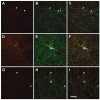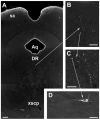Retinopetal axons in mammals: emphasis on histamine and serotonin
- PMID: 16877274
- PMCID: PMC3351198
- DOI: 10.1080/02713680600776119
Retinopetal axons in mammals: emphasis on histamine and serotonin
Abstract
Since 1892, anatomical studies have demonstrated that the retinas of mammals, including humans, receive input from the brain via axons emerging from the optic nerve. There are only a small number of these retinopetal axons, but their branches in the inner retina are very extensive. More recently, the neurons in the brain stem that give rise to these axons have been localized, and their neurotransmitters have been identified. One set of retinopetal axons arises from perikarya in the posterior hypothalamus and uses histamine, and the other arises from perikarya in the dorsal raphe and uses serotonin. These serotonergic and histaminergic neurons are not specialized to supply the retina; rather, they are a subset of the neurons that project via collaterals to many other targets in the central nervous system, as well. They are components of the ascending arousal system, firing most rapidly when the animal is awake and active. The contributions of these retinopetal axons to vision may be predicted from the known effects of serotonin and histamine on retinal neurons. There is also evidence suggesting that retinopetal axons play a role in the etiology of retinal diseases.
Figures









Similar articles
-
Histamine immunoreactive axons in the macaque retina.Invest Ophthalmol Vis Sci. 1999 Feb;40(2):487-95. Invest Ophthalmol Vis Sci. 1999. PMID: 9950609 Free PMC article.
-
Serotonergic retinopetal axons in the monkey retina.Curr Eye Res. 2005 Dec;30(12):1089-95. doi: 10.1080/02713680500371532. Curr Eye Res. 2005. PMID: 16354622 Free PMC article.
-
Organization of retinopetal axons in the optic nerve of the cichlid fish, Herotilapia multispinosa.J Comp Neurol. 1990 Apr 15;294(3):418-30. doi: 10.1002/cne.902940310. J Comp Neurol. 1990. PMID: 2341619
-
Terminal nerve and vision.Microsc Res Tech. 2004 Sep;65(1-2):25-32. doi: 10.1002/jemt.20108. Microsc Res Tech. 2004. PMID: 15570588 Review.
-
Ganglion cell axon pathfinding in the retina and optic nerve.Semin Cell Dev Biol. 2004 Feb;15(1):125-36. doi: 10.1016/j.semcdb.2003.09.006. Semin Cell Dev Biol. 2004. PMID: 15036215 Review.
Cited by
-
The effect of optic nerve section on form deprivation myopia in the guinea pig.J Comp Neurol. 2020 Dec 1;528(17):2874-2887. doi: 10.1002/cne.24961. Epub 2020 Jun 26. J Comp Neurol. 2020. PMID: 32484917 Free PMC article.
-
A vision science perspective on schizophrenia.Schizophr Res Cogn. 2015 Jun;2(2):39-41. doi: 10.1016/j.scog.2015.05.003. Schizophr Res Cogn. 2015. PMID: 26345386 Free PMC article. No abstract available.
-
Circadian clock organization in the retina: From clock components to rod and cone pathways and visual function.Prog Retin Eye Res. 2023 May;94:101119. doi: 10.1016/j.preteyeres.2022.101119. Epub 2022 Dec 8. Prog Retin Eye Res. 2023. PMID: 36503722 Free PMC article. Review.
-
The electroretinogram as a method for studying circadian rhythms in the mammalian retina.J Genet. 2008 Dec;87(5):459-66. doi: 10.1007/s12041-008-0068-5. J Genet. 2008. PMID: 19147934 Review.
-
Sex-Specific Retinal Anomalies Induced by Chronic Social Defeat Stress in Mice.Front Behav Neurosci. 2021 Aug 12;15:714810. doi: 10.3389/fnbeh.2021.714810. eCollection 2021. Front Behav Neurosci. 2021. PMID: 34483859 Free PMC article.
References
-
- Ramon y, Cajal S. The Structure of the Retina. Springfield: Charles C Thomas; 1892. p. 196.
-
- Polyak SL. The Retina. Chicago: The University of Chicago Press; 1941.
-
- Schütte M. Centrifugal innervation of the rat retina. Vis Neurosci. 1995;12:1083–1092. - PubMed
-
- Bons N, Petter A. Retinal afferents of hypothalamic origin in a prosimian primate: Microcebus murinus. Study using retrograde fluorescent tracers. Comptes rendus de l’Academia des sciences Serie III. 1986;303:719–722. - PubMed
Publication types
MeSH terms
Substances
Grants and funding
LinkOut - more resources
Full Text Sources
